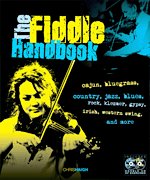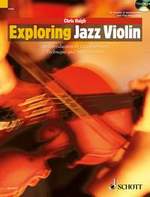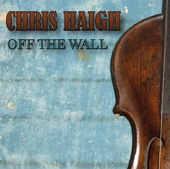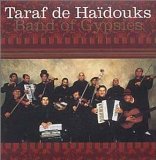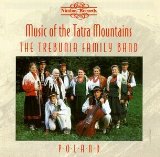
MENU TO FIDDLE STYLES:
Eastern European and gypsy fiddle
To lump together an area of such diversity and richness of culture as the whole of eastern Europe may seem an unnecessarily crude device, but at least Joe Stalin thought it was a good idea!
A good place to start when looking at the fiddle music of Eastern Europe is Hungary and Romania. The region stretches from the sophisticated former Austro-Hungarian empire in the west to the more archaic Ottoman-influenced Balkans to the southeast. One unifying element is the large population of gypsies, many of whom are skilled professional musicians. They tend to live together as extended families in a special street at the edge of town, often called in Romania the Strada Lautari (Musicians Street). A typical ensemble will be led by the Primás,the lead violinist. There will be one or more rhythm or accompanying fiddles; these may be the 3-stringed contra, (or Kontra)- more of a viola than a violin- held down on the chest and with a flattened bridge to allow easy chord playing, and typically tuned GDA. The bass may be plucked or bowed; in the Eastern Carpathians the crude cello-like gardon is violently beaten with a wooden stick (insulting bass player joke deleted!). Other instruments may include the cimbalom (a type of hammered dulcimer), the piano accordion, clarinet and (in the Transylvanian regionn of Maramures), guitar.
Three-stringed Contra
Gypsy Fiddle
Gypsy bands have been common in central Europe since the mid eighteenth century; one of the most famous early bandleaders was János Bihari, dubbed "the Napoleon of the Fiddle" because they shared the same year of birth, 1769. Musical tradition and technique have been passed down though the generations, and violinists such as Sándor Lakatos and Sándor Fodor still find receptive audiences both for recording and live performance. Hungary has the Rajco music School for Gypsies where talented children are taught from an early age, learning the tricks, techniques and repertoire of gypsy music; this was founded in 1952 by the Romany fiddler and teacher Gyla Farcas; today there is a professional gypsy orchestra called the Rajco Ensemble, made up of graduates from the school.
Rajco Ensemble
Recently we have been treated in London to concerts by the fabulous Taraf de Haidouks, a gypsy band from the village of Clejani near Bucharest in Romania. Sophisticated city audiences are nonplussed when this diverse group, ranging from adolescents to toothless old-timers leave the concert stage and immediately begin either busking or attempting to sell their instruments to the dispersing crowd!
Gypsy violinists tend to be highly skilled, constantly striving to impress with their virtuosity and passion. Their playing swoops dramatically from the highest to the lowest positions, uses cascades of arpeggios and heart-stopping chromatic runs, harmonics, pizzicato, exaggerated vibrato and a rate of acceleration which will have you pinned to the back of your seat-and that's all within the space of one tune!
Gypsy repertoire
In typical gypsy fashion, repertoire reflects the popular tunes of the local area, but simple tunes are transformed into masterpieces of emotion and technique. A favourite throughout the world of gypsy violin playing is The Lark, where high squeaks, trills and harmonics imitate birdsong. The Verbunk is a type of tune originally associated with army recruiting ceremonies and generally has a slow, romantic introduction reflecting the sadness of departure, a bold and uplifting middle section, and a frantically paced climax depicting the excitement and adventure ahead. This is sometimes confused with the Czardas, a type of couple dance named after the Hungarian inn or tavern. The most famous czardas is that written by the Italian composer Monti. He was just one of many 19th and early 20th century composers to have been captivated by gypsy music, and it is fitting that many of their works have been in turn assimilated by the gypsies. Thus you are quite likely to hear gypsy orchestras playing versions of the Brahms Hungarian dances, Dinicu's Hora Staccato, Sarasate's Zigeunerweisen, Liszt's Hungarian Rhapsodies or Hubay's Hejre Kati. Widely played traditional tunes include the Hungarian One Kitten, Two Kittens with its alternating pizz and arco passages; the stately Slowly flows the River Maros, or the Romanian Sinai Hora.
Aside from gypsy musicians, there is also a strong tradition of purely Romanian and Hungarian folk fiddling. Particularly important is the mountainous region of Transylvania, famed for its music as well as for its bloodthirsty legends. Though lying today within Romania, it has a large ethnic minority of Hungarians, who because of the region's isolation and poverty have maintained a culture and way of life which has changed little in centuries. Transylvania has a special place in the hearts of Hungarians as a vital link with their past. They watched in horror as the dictator Ceausescu laid out his plans to totally destroy every Transylvanian village; his downfall came not a moment too soon. It was largely a feeling of solidarity with their ethnic cousins across the border that led bands such as Sebo (led by Halmos Bela) and Muzsikás to start the tánchás (dance house) movement in the 70's, recreating at packed venues the old peasant songs, dances and tunes. Up until then folk music in the towns had been little more than a tool of the state, a hollow token to cultural diversity.
A key technique in Hungarian, and more especially Romanian violin playing is the vibrato trill. If the first finger is holding down a note, the second finger is held hard against it. As the hand rocks to allow vibrato, the second finger rolls on and off the string, so close to the first note that the pitch barely changes but the timbre of the note is quite different.Another interesting technique, featured on the Monti Czardas, is the type of harmonic that appears in the slow middle section. Each melody note is fingered with the first finger, whilst the fourth finger is placed lightly on the string a fourth higher. This produces a true harmonic on each note which gives the effect of a ghostly whistling. It's the only type of harmonic which can actually slide from one note to the next. It took me about fifteen years to get the hang of this one!
Another common technique, featured in Monti's Whistle Hora, is the very fast slide on the E string up to the top E harmonic.
Gypsy fiddle tunings
Gypsy fiddlers will sometimes tune the fiddle up a semitone make the E string play an F, giving a brighter tone. An interesting technique used by some Hungarian and Romanian gypsies is to loosen the A string and place it in the same nut groove as the E string ( so that the two strings share the same groove). The A string is then tuned an octave below the E string, and then any melody played on these strings will be doubled in two octaves- sounding in fact like two fiddles.
Stroh FiddleA strange variant on the normal fiddle is the horn violin, commonly found in the Bihar region of northwest Transylvania, and based on the Stroh Phonofiddle. A metal horn and diaphragm are attached to an otherwise normal violin, giving a loud and piercing tone. Another fiddle variant is the Keman of southwest Moldavia, sporting a number of sympathetic strings.
A strange variant on the normal fiddle is the horn violin, commonly found in the Bihar region of northwest Transylvania, and based on the Stroh Phonofiddle. A metal horn and diaphragm are attached to an otherwise normal violin, giving a loud and piercing tone. Another fiddle variant is the Keman of southwest Moldavia, sporting a number of sympathetic strings. Balkan fiddle-the Gadulka
To the south of Romania lie Bulgaria and Macedonia, which have in common a dance music noted for the outrageous complexity of its rhythm, and the remarkable gadulka on which it is played. This ancient relative of the fiddle is probably descended from the medieval rebec. It is held upright on the knee or hangs from a belt, and is bowed with an underhand grip. The three melody strings, tuned AEA, are pressed with the nails or finger pads, as the neck has no fingerboard. Two sets of sympathetic strings lie against the pear-shaped body, giving the gadulka a haunting echoey sound.
Fiddles in the High Tatra
The mountain culture of Transylvania extends north into the Tatras of Poland, where the fiercely independent Gorale people farm in the Podhale region. Many of their songs and tunes hark back to the 17th and 18th Century, when heroic mountain brigands maintained a spirited guerrilla war against feudal landlords. Unlike the relatively tame diet of polkas and waltzes found in lowland of Poland (and I believe there's a song there somewhere!), the Gorale people have a high-octane dance music featuring much yelping, scraping and droning.
Wedding bands such as The Trebunia Family Band feature lead fiddle (the prym), two or more backing violins and a small three-stringed bass; many of the tunes are angular, featuring a strange five-bar pattern and a distinctive scale, whilst the pitch and intonation demonstrate a continuing stubborn unconformity to decadent western values.
Trebunia Family Band
Poland has several unique fiddles. One of these is the Suka; like the Gadulka this is played vertically, on the knee or hanging from a strap, and the strings are stopped at the side with the fingernails. The body of the instrument is very similar to the modern violin, but the neck is very wide, and the pegbox is crude. This is thought to be the "missing link" between the upside-down or "knee chordophone" instruments, and the modern violin. It died out, and was known only from drawings of a single specimen displayed at an exhibition in 1888. A century later the instrument was reconstructed by Andrzej Kuczkowski, and is today being popularised by string specialist Maria Pomianowska.
By way of reparations for 45 years of Cold War, Russia gets relegated to last place in this brief roundup of East European folk music, but it must be said that some of the finest and most widely played tunes originate here, including Two Guitars, Kalinka, Katyusha and the indispensable Dark Eyes.
We are fortunate in the UK in having many excellent Russian musicians now living and working here. No-one who has seen the breathtaking Loyko will forget the masterful fiddling of Sergei Erdenko and Oleg Ponomarev.
Loyko
---------------------------------------------------------------------------------------------------------------------
Eastern European Fiddle Tunes-80 Traditional Pieces for Violin BK/CD (Schott World Music Series)
Pete Cooper hooks us right from the start, with a folk tale of gypsies, fiddles, and the devil. Fiddling in eastern Europe is more than just a bit of light entertainment; it’s the stuff of history, magic and legend. Cooper immediately banishes the idea that there is a single east European style; it ranges from the virtuosic semi –classical gypsy fiddling to relatively basic and rootsy folk playing.
For those nervous of venturing much beyond first position, you’ll be pleased to hear that this book is geared more towards the latter than the former end of the spectrum. With a modesty rare among tune book writers, Pete admits at the outset to not being an expert in any of the styles covered; nevertheless he is able, in his words, to ably ‘navigate the cultural geography”, leading us gradually south along the Carpathians from Poland down to Macedonia. We are introduced briefly to some of the scales and modes which make much of this music so exotic to western ears, to the concept of rhythmic chording (quite unfamiliar to those brought up on the Anglo-Celtic tradition), and to the initially baffling asymmetric rhythms which become increasingly common as you approach the sunny south eastern corner of Europe. The tune section starts with Polish mazurkas, obereks, krakoviaks, polonaises and polkas from Poland, and from Ukraine are Brigands dances, waltzes and kolomykas, and some well known Russian songs. Klezmer tunes are represented by a series of freylechs and solo horas, some of which have become some standards either from their inclusion in Harry Sapoznik’s The Compleat Klezmer, or from famous recordings (Muszicas’s Lost Jewish Music of Transylvania ) From Hungary are Verbunks (recruiting dances), czardas dance tunes, and legenyes (lads’ dances) and, in case you were enjoying yourselves too much, a funeral dance. The rhythms begin to get more challenging as we enter Romania, with invirtitas (7/8) and horas (5/8), while Bulgarian tunes include ruchenitsas (7/16), kopanitsas (11/16) and Oros (13/8).
Many of the tunes are arranged for two fiddles and all are given chord symbols, making these a useful starting point for band performances. It would be possible to plaster these tunes with annotation on ornaments, drones, fingering and bow marks; fortunately, Pete has left the music relatively uncluttered, pointing out that for stylistic authenticity there is no substitute for listening to the original source recordings. Pete’s own accompanying cd of solo fiddle is characteristically clear and robust, with the music an exact transcription of his own arrangements and playing of the tunes. The Schott formula of including textual translations in German and French limits the space available for notes on the individual tunes but, aware that every tune has its own, often fascinating story, Pete has provided extensive notes on his own website. This is the most enjoyable and comprehensive survey of east European fiddle tunes I have come across. Buy it!
---------------------------------------------------------------------------------------------------------------------
LINKS:
- The Gadulka (From "staying in Tune"
- The Gadulka (by David Brown, from "Lark in the Morning"
- The Contra (From "Staying in Tune"
- Stroh fiddle (from "Staying in tune"
- Loyko
- Balkanfolk.com
Chris Haigh is a London-based fiddle player who specialises in Klezmer, gypsy and East European styles. He plays with a trio, Klezmania, doing lots of Jewish weddings and Bar Mitzvahs; this band does a mixture of traditional Klezmer and Israeli tunes along with some jazz improvisation. Tziganarama is Chris's own trio, playing a wide range of Jewish, Russian, Balkan and gypsy music, whilst The Kremlinaires is Chris's wacky 7-piece Soviet Swing band.
Chris sometimes plays solo or as a duo with accordion, going "around the tables" at a dinner.
He gives workshops on klezmer fiddle style, demonstrating techniques and ornamentation, describing the different tunes types and scales used in klezmer.
He writes original klezmer melodies; his tune "Klezmania" was used on a worldwide TV ad for Nike!
RETURN TO FIDDLINGAROUND HOMEPAGE
BY CHRIS HAIGH
Eastern European Fiddle Tunes-80 Traditional Pieces for Violin BK/CD (Schott World Music Series)
(see review at bottom of page)
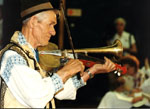
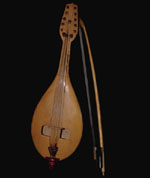
.jpg)
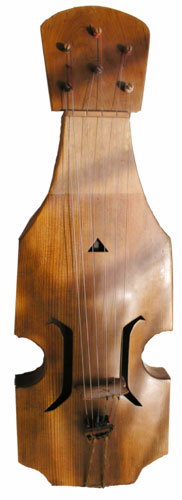
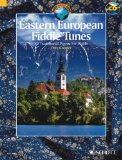
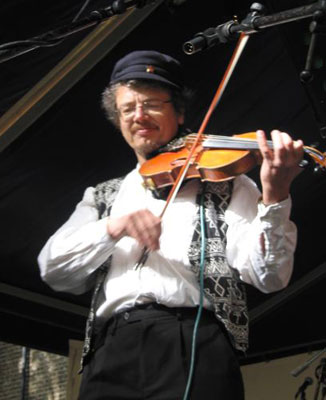
.jpg)
